Exploring Drip Line Fertilizer Injectors in Agriculture

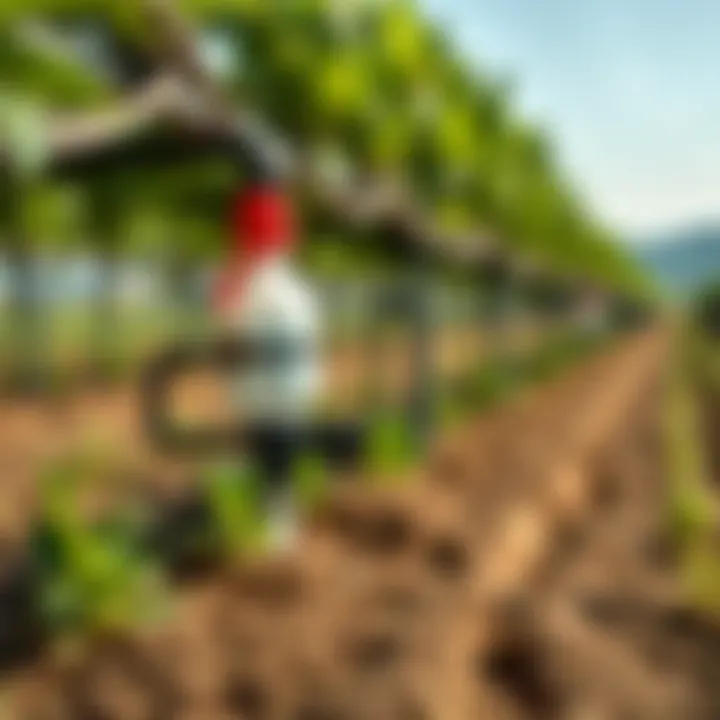
Intro
Drip line fertilizer injectors have become indispensable tools in the realm of modern agriculture. As growers seek to maximize efficiency and sustainability, understanding how these systems operate is critical. This exploration will reveal the inner workings, benefits, and potential hurdles associated with drip line injectors, equipping both novice and experienced practitioners with the knowledge necessary to make informed decisions.
In recent years, there’s been a noticeable shift towards precision agriculture, where every drop counts. These advanced systems allow for the targeted delivery of nutrients, ensuring that crops receive precisely what they need for optimal growth. With this guide, farmers will not only learn about the function and types of drip line fertilizer injectors but also gain insights into how to effectively integrate them into their farming practices.
Prologue to Drip Line Fertilizer Injectors
Drip line fertilizer injectors are gaining traction, especially among modern agricultural enthusiasts who are looking to streamline their farming practices. Recognized for their efficiency in nutrient delivery, these injectors play a pivotal role in drip irrigation systems by ensuring that crops receive the exact amount of fertilizers needed to thrive. This section lays the groundwork for understanding the significance and practical applications of these devices in contemporary agriculture.
Definition and Purpose
At its core, a drip line fertilizer injector is a device designed to introduce fertilizers into an irrigation system. Unlike traditional methods that often lead to uneven distribution, these injectors offer a targeted approach. They can mix liquid fertilizers into irrigation lines, allowing nutrients to be delivered directly to the root system of plants with precision. This means that rather than relying on soil quality or extensive rainfall, farmers can provide consistent and optimized nutrition to their crops.
Thus, the main purpose of these injectors extends beyond mere delivery; they also aim to enhance overall crop yield, ensuring that each plant gets what it needs without wastage. This approach not only saves time but can also significantly reduce fertilizer costs in the long run.
Historical Context
The inception of drip line fertilizer injectors has roots traced back to the late 20th century, a time when agricultural practices began to shift towards more sustainable methods. Initially, irrigation systems relied heavily on surface watering and broad applications of fertilizers, leading to a higher risk of runoff and leaching into waterways.
As agriculture started prioritizing efficiency, innovators sought out methods to minimize environmental impact while maximizing productivity. The development of modern drip irrigation systems coincided with improvements in fertilizer technologies. By integrating these developments, drip line fertilizer injectors emerged as a robust solution to the challenges faced by farmers—especially in water-scarce regions.
Today, these systems are recognized not just as a means of enhancing productivity but also as a step towards sustainable farming practices. The historical evolution of these devices aligns with a broader movement within agriculture to adopt practices that ensure the health of both crops and the environment.
In sum, understanding the origins and functions of drip line fertilizer injectors provides crucial insight into their role in modern agriculture, especially as global food demands continue to rise.
How Drip Line Fertilizer Injectors Work
Understanding how drip line fertilizer injectors operate is fundamental for anyone involved in agricultural practices. These systems represent a blend of precise technology and practical application, offering a nuanced approach to delivering nutrients right where plants need them. The ability to control the nutrient concentration and manage water usage efficiently can significantly impact crop yield and overall farm productivity.
Principles of Operation
At their core, drip line fertilizer injectors work by integrating the principles of fluid dynamics with agricultural needs. The main idea is straightforward: nutrients are dissolved in water, and that solution is then injected into a drip irrigation system.
- Pressure Differentials: Most systems utilize the difference in pressure to draw the fertilizer solution from a reservoir into the irrigation pipes. A pump maintains the necessary pressure, ensuring that the nutrient solution reaches the plants efficiently.
- Gravity and Suction: Injector types may vary, but whether using venturi or piston systems, they all depend on gravity or suction principles to function effectively. As water flows through the system, it creates a vacuum that pulls in the fertilizer from a separate tank.
- Optimization of Flow Rates: Adjusting the flow rate of water can affect how much fertilizer is injected. This capability allows farmers to tailor the nutrient application precisely to the growing conditions and specific plants being fed.
Overall, understanding these principles helps farmers appreciate the efficiency of fertilizer injectors and how they enhance resource management in farming, thus minimizing waste.
Components of a Drip Line Injector System
A typical drip line fertilizer injector system comprises several key components, each playing a crucial role in the efficient delivery of nutrients:
- Injector: This is the heart of the system where the mixing of water and fertilizers occurs. Different types of injectors exist as mentioned earlier, with each having unique operational strengths.
- Fertilizer Tank: Usually a separate reservoir where the fertilizer solution is mixed before being injected into the drip lines. The size and shape can vary based on the scale of farming operations.
- Controller: An electronic or mechanical device that manages the timing and quantity of fertilizer injection. More sophisticated systems come equipped with sensors to monitor variables like pressure and flow rates.
- Drip Tubing: The pipes or tubing that carry the nutrient-rich solution directly to the plant roots. The installation must be precise to avoid any nutrient loss due to leaks or blockages.
- Filtration System: Essential for preventing any particles from the fertilizer solution from clogging the drip emitters. A good filtration system ensures longevity and efficiency.
- Backflow Prevention Device: This component protects the water supply from contamination by preventing any backflow of the fertilizer solution into the potable water supply.
Types of Drip Line Fertilizer Injectors
The world of agriculture is continually evolving, with advances that allow for more effective and sustainable practices. Drip line fertilizer injectors stand at the forefront of these advancements, and understanding their various types is crucial for anyone in the field. Choosing the right type can affect the efficiency of nutrient delivery, water usage, and ultimately, crop yields. Each type has its own unique features, benefits, and drawbacks that must be considered for optimal performance.
Venturi Injectors
Venturi injectors are often the most common choice in drip irrigation setups due to their simplicity and effectiveness. Utilizing the principle of water flow and pressure differentials, these injectors mix fertilizers into the water line without needing additional pumps. The moment water flows through a constricted section of the tube, the pressure drops, creating a vacuum that pulls in the fertilizer. It’s like vacuuming up dirt in a tight corner; the faster the water moves, the more it can pull in.
Benefits:
- Cost-Effective: There are no mechanical parts, which reduces initial setup costs and maintenance requirements.
- Simplicity: Easy to install and requires little technical know-how beyond basic plumbing skills.
Considerations:
- Pressure Sensitivity: Venturi injectors depend on the pressure of the water source. If the pressure drops below a certain point, they may fail to operate efficiently. Therefore, ensuring consistent water pressure is crucial.
Piston Injectors
Piston injectors bring a different approach to the table by using a mechanical piston to control the intake of fertilizer. These are particularly useful in situations where precise dosing is critical. When the water moves through the injector, it activates a piston mechanism that draws in the fertilizer at a consistent rate. Imagine it like a chef carefully pouring syrup into a cake batter—too much or too little could ruin the recipe.
Benefits:
- Precision: Offers a highly accurate delivery of fertilizers, making it suitable for high-value crops that require specific nutrient levels.
- Adjustability: Piston injectors often allow farmers to easily adjust the delivery rates based on crop requirements or growth stages.


Considerations:
- Complexity and Cost: While effective, these injectors tend to be more complex and expensive than their Venturi counterparts, requiring a certain level of technical understanding for installation and maintenance.
Electronic Injectors
For those looking to fully optimize their nutrient delivery, electronic injectors provide a high-tech solution. These systems combine automation with advanced monitoring technologies to deliver precise amounts of nutrients based on real-time data, such as soil health and moisture levels. Think of it as a smart assistant managing your nutrition, adapting as needed for maximum growth potential.
Benefits:
- Automation: Reduces labor time and expertise needed for manual adjustments, allowing for more consistent fertilization.
- Data-Driven: Can integrate with other farming technologies, offering insights into crop health and environmental factors.
Considerations:
- Investment Required: The initial costs can be quite high and might not be suitable for smaller-scale operations. Farmers need to weigh the benefits against potential returns on investment.
"Selecting the right type of injector is as crucial as the fertilizer itself; it can mean the difference between a flourishing crop and a failed harvest."
Benefits of Using Drip Line Fertilizer Injectors
Farmers today are always looking for ways to maximize their yields while minimizing their costs. In this quest, drip line fertilizer injectors have emerged as vital tools that address multiple needs in modern agriculture. They provide a solution that blends efficiency, conservation, and cost management, all while enhancing crop productivity. Let’s delve into the string of benefits these systems present, breaking each down into core elements that every farmer should consider.
Efficient Nutrient Delivery
Drip line fertilizer injectors excel in delivering nutrients right to the plant roots where they are needed most. This efficiency not only leads to better uptake of essential nutrients but can also reduce waste.
- Precise Application: The injector allows for controlled releases. Whether you're working with nitrogen, phosphorous, or potassium, the right amount can be delivered at the perfect timing. No more guessing games when it comes to feeding your crops.
- Minimized Runoff: Traditional methods of fertilization often result in runoff that can carry nutrients away from the target area, causing environmental concerns. With a drip line system, fertilizers are applied directly into the soil, where they remain, thus minimizing potential runoff and leaching. This not only helps in retaining soil productivity but is also a step towards sustainable farming.
"With drip line systems, farmers can manage nutrients effectively, potentially increasing yields while fostering better environmental practices."
Water Conservation
Water scarcity is becoming a pressing issue in many regions, making efficient water usage paramount. Drip line fertilizer injectors are champions at conserving water while achieving optimal agricultural outcomes.
- Targeted Watering: Unlike overhead irrigation that blankets an area, drip systems concentrate water flow directly to the roots of the plants. This means less evaporation and reduced water consumption.
- Reduced Weeds: By applying water directly to the soil instead of the foliage, farmers can also inhibit weed growth. Less water on the weed surface means they don’t thrive nearly as well, conserving resources for crops instead.
Reduced Labor Costs
Managing a farm comes with labor costs that can often spiral out of control, especially during planting and harvesting seasons. By implementing drip line fertilizer injectors, labor efficiency can improve significantly.
- Less Frequent Interventions: Drip systems automate much of the watering and fertilizing process. This means less time spent manually applying fertilizers or checking for deficiencies, freeing up labor for other essential tasks.
- Simplified Maintenance: Once installed, these systems require less hands-on management. Maintenance checks can be performed less frequently, which saves both time and money.
In such volatile market conditions, the importance of every dollar spent cannot be overlooked. These systems not only enhance productivity on the farm but also achieve significant cost reductions for farmers looking to stay competitive. As more growers recognize the multifaceted benefits of drip line fertilizer injectors, it's clear that they are becoming a cornerstone of modern agricultural strategies.
Challenges and Limitations
When delving into the realm of drip line fertilizer injectors, it’s crucial to recognize the hurdles that accompany their use in agricultural settings. Understanding these challenges helps farmers and enthusiasts make informed decisions, ensuring they extract the maximum benefit from this technology. While drip systems promise a host of advantages, they also come with their share of limitations that can impact their feasibility and overall effectiveness.
Initial Setup Costs
Getting a drip line fertilizer injector system up and running isn't a walk in the park. The initial setup costs can be quite hefty, acting as a gatekeeper for many small-scale farmers. From purchasing specialized equipment to laying out the necessary infrastructure, these expenses can add up quickly.
- System Components: Manufacturers like Netafim and Rain Bird offer various components like filters, emitters, and main lines, all of which require upfront investment. This isn’t just pocket change; a full setup for a medium-sized farm might run into thousands of dollars.
- Installation Fees: If you’re not the DIY type, hiring professional help can further inflate these costs. Skilled technicians are often necessary to properly install and calibrate the system, ensuring it works as intended.
- Potential for Hidden Costs: It's also worth noting that many farmers overlook ongoing operational expenses. Water quality issues or unforeseen repairs can crop up, requiring additional funds that weren't part of the original budget.
Despite these challenges, many find that the long-term benefits often outweigh these initial hurdles when implemented correctly.
Need for Technical Knowledge
Another formidable challenge surrounds the need for technical know-how. Operating a drip line fertilizer injector goes beyond simply turning a valve. It demands a certain level of expertise that not all farmers possess.
- Understanding System Dynamics: Farmers must grasp the intricacies of water pressure, flow rates, and nutrient mixing. This isn’t common knowledge for everyone, especially if they haven't had formal training in agronomy or related fields.
- Maintenance and Troubleshooting: Regular maintenance is vital to keep systems running smoothly. Farmers often find themselves grappling with clogged emitters or malfunctioning pumps, issues that require some mechanical knowledge to resolve. An uninformed farmer may inadvertently cause more damage while trying to fix a simple problem.
- Continual Learning: The landscape of agricultural technology is forever changing, with new advancements emerging regularly. Keeping abreast of these developments demands a commitment to continuous education, which can be daunting for those already stretched thin with day-to-day farm operations.
In summary, while drip line fertilizer injectors present an opportunity for efficient agriculture, the initial costs and technical demands can pose significant challenges. It's essential for prospective users to weigh these factors carefully and consider seeking assistance or training to maximize their investment in this technology.
"Understanding the limitations of any system is as critical as recognizing its advantages. Knowledge fosters preparedness and equips farmers to tackle challenges head-on."
By navigating these hurdles with careful planning and education, farmers can better position themselves to harness the benefits of drip line fertilizer injectors.
Installation of Drip Line Fertilizer Injectors
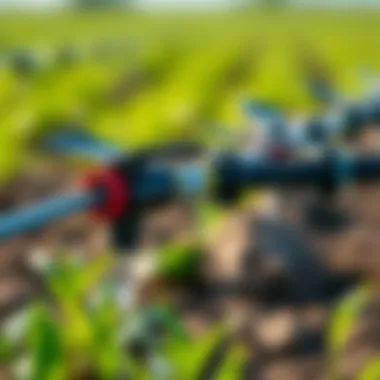
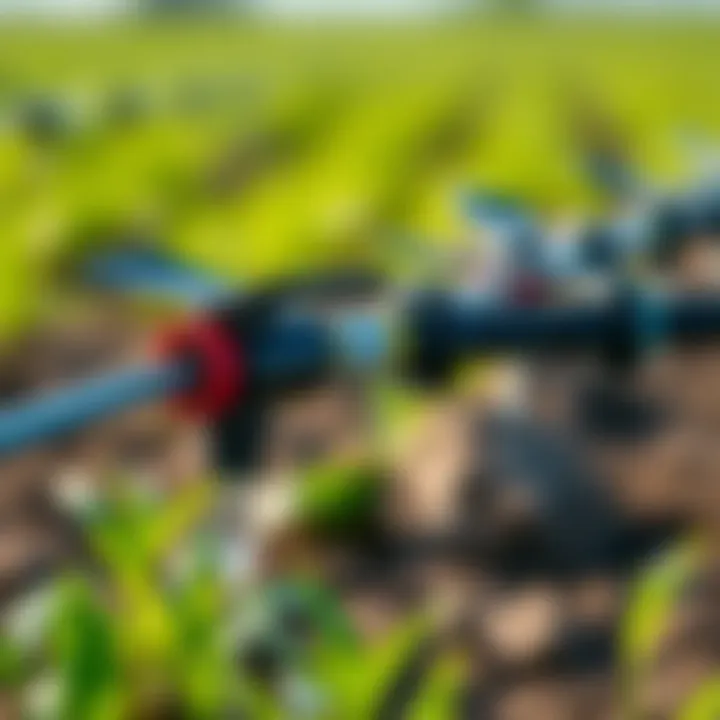
The installation of drip line fertilizer injectors stands as a crucial step in leveraging this innovative agricultural technology for enhanced crop yields. A well-executed installation not only maximizes the efficiency of nutrient delivery but also optimizes the use of water resources—a vital consideration in today's farming practices. Let's dive into the fundamentals of site assessment and planning, setting the stage for a robust drip line fertilizer system.
Site Assessment
A comprehensive site assessment is an absolute necessity before any installation effort. This is where farmers and agronomists roll up their sleeves and analyze the land, taking various factors into consideration that will determine the success of the drip line system.
Here are some key points to evaluate:
- Soil Type and Quality: Knowing your soil type helps gauge its capacity to retain moisture and nutrients. Sandy soils drain quickly, while clay soils can hold water for longer periods. Understanding the soil profile allows for tailored nutrient application.
- Topography of the Land: The layout of the land influences how water flows and drains. A flat area may present different challenges compared to a sloped land, which can lead to runoff issues.
- Water Source Availability: Considering where your water is coming from is critical. Is it a well, a nearby river, or a reservoir? Each has its own implications for pressure and flow rate.
- Existing Infrastructure: Assessing current irrigation systems and how they can integrate with the new injectors is vital. Compatibility can save labor and resources.
In essence, taking the time to properly assess the site can save headaches down the road. This initial step allows for an efficient system design, paving the way for effective installations.
Planning and Design
Once the site assessment is complete, the next phase is planning and design. This stage is where agricultural science meets practical application, and attention to detail is paramount.
A few important design factors to keep in mind include:
- System Layout: The arrangement of the drip lines should align with the rows of crops. Making sure each plant gets adequate coverage is key. A well-planned layout minimizes wastage and enhances nutrient uptake.
- Injector Capacity and Specifications: Different crops have varying nutritional requirements. Ensuring the selected injector can accommodate these needs is vital. Factors like the rate of fertilizer injection and water pressure dictate the efficiency of nutrient delivery.
- Control Mechanisms: Integrating controllers that automate the delivery of nutrients can streamline operations. This can include timers or soil moisture sensors that make adjustments based on real-time data.
- Compatibility with Other Technologies: Planning for future advancements is wise. Ensuring your system can be adapted or integrated with smart agriculture technologies ensures longevity and versatility.
"A solid plan is the cornerstone for the system’s success; skip it, and you risk running around like a chicken with its head cut off!"
In summary, a sound installation plan springs from comprehensive site assessments followed by careful design considerations. By anchoring the installation process on these two pillars, farmers set the foundation for a productive and efficient fertilization strategy. This creates an ecosystem where crops flourish and resources are wisely used, maximizing both output and sustainability.
Maintenance Best Practices
Maintaining drip line fertilizer injectors is like tending to a garden; you gotta put in the effort to reap the rewards. Regular maintenance can make a significant difference in how effectively these systems perform. Skimping on upkeep might lead to inefficient nutrient delivery, system failures, or even costly repairs. The essentials of maintenance generally include regular checks and cleaning procedures, but let’s break those down further.
Regular System Checks
Regular system checks are your first line of defense against malfunctioning equipment. These checks should not be a once-a-year event either; establish a routine so it becomes second nature.
- Visual Inspections: Start with visual inspections. Check for leaks, cracks, or any signs of wear and tear. If a part looks like it's been through the wringer, it probably needs a closer look.
- Check Pressure Levels: Monitor the pressure levels in your system. A drop in pressure could indicate a blockage somewhere in the line. Blockages can create a cascade of issues, including uneven nutrient delivery.
- Flow Rate Monitoring: Use flow meters if they are in your system. They provide insight into how much nutrient solution is flowing through. If the flow rate is inconsistent, you might need to pull apart some connections to get to the root of the problem.
- System Calibration: Periodically recalibrate your injectors to ensure they are delivering the correct dosage of fertilizer. Inaccurate delivery can lead to nutrient imbalances, which in turn affects crop growth.
The importance of these checks cannot be overstated. They help identify minor issues before they snowball into major headaches that could undermine your agricultural efforts. As the saying goes, "An ounce of prevention is worth a pound of cure."
Cleaning Procedures
Cleaning your drip line fertilizer injector system is not just good hygiene; it’s essential for longevity and efficiency. Here’s how to keep things sparkling:
- Flush the System: Flushing your system with clean water helps remove residual fertilizers and micronutrients that can build up over time. It’s a straightforward process but can save you a lot of trouble later on.
- Use Proper Cleaning Agents: Sometimes water isn’t enough. Depending on what fertilizers are used, a cleaning agent might be necessary to combat build-up. Make sure to follow the manufacturer’s advice for compatible cleaning agents, as not all chemicals are created equal.
- Component Cleaning: Disassemble components like filters and emitters for thorough cleaning. A toothbrush or a small brush can aid in scrubbing parts that have collected dirt or fertilizer coating. Do this at least once a season to keep everything functioning smoothly.
- Inspect and Replace: During cleaning, do a quick inspection of the o-rings and seals for any signs of damage. It’s easy to get complacent, thinking that things will always work fine. But a small problem today could snowball into a disaster tomorrow.
Cleaning should be a regular part of your system maintenance schedule. It is, after all, easier to keep things clean from the get-go than to deal with stubborn clogs later. As a rule of thumb, always remember: "What flows in must flow out, and what clogs up must get cleaned out!"
By regularly checking your system and adhering to thorough cleaning procedures, you ensure that your drip line fertilizer injectors operate at peak performance. Not only does this enhance efficiency, but it ultimately leads to healthier crops and a more sustainable farming operation.
Integration with Other Agricultural Technologies
Integrating drip line fertilizer injectors with other agricultural technologies can significantly improve both effectiveness and efficiency in farming practices. It’s not just about having a nifty tool; it’s about how these systems can enhance one another to create a seamless farming experience. Combining these injectors with existing irrigation systems is becoming a game-changer for many farmers. The art of blending methods can lead to not only better crop yields but also a reduction in resource waste.
Combining with Irrigation Systems
When you merge drip line fertilizer injectors with irrigation systems, you are looking at a method called fertigation. This integrates the application of fertilizers directly with irrigation water, saving time and ensuring that the right amount of nutrients reaches the plants at the right moment. Fertigation helps in reducing nutrient leaching, which frequently occurs with traditional methods of fertilizer application.
For instance, using a drip irrigation system alongside fertilizer injectors means that water carrying the fertilizer is delivered just where it’s needed – right at the root zone. This focused approach not only promotes healthier plant growth but also lessens the likelihood of water pollution.
Some key points about combining these systems include:
- Efficiency in Nutrient Uptake: Roots are quick to absorb nutrients when they are delivered in moisture, leading to healthier growth.
- Cost-Effectiveness: Less fertilizer runoff means less money spent on inputs while optimizing the output.
- Labor Savings: Implementing drip systems frees up time for farmers who no longer need to manually apply fertilizers.
"Integrating drip systems with fertilization methods can optimize water use and enhance crop yield significantly."
Utilizing Fertigation Techniques
The practice of fertigation is not merely a trend; it’s a vital component that reflects the evolution of farming technologies. This method enables farmers to take full advantage of drip line fertilizer injectors, allowing precise control of nutrient levels. By carefully managing how much fertilizer is injected into the irrigation system, farmers can tailor their approaches based on specific crop needs, soil conditions, and even weather patterns.
In utilizing fertigation techniques, several factors come into play:
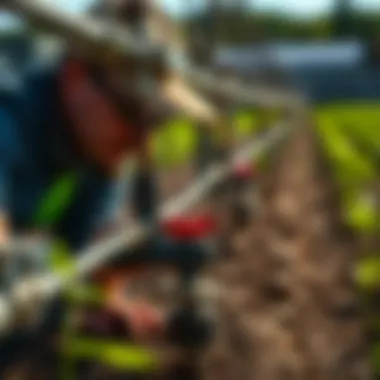
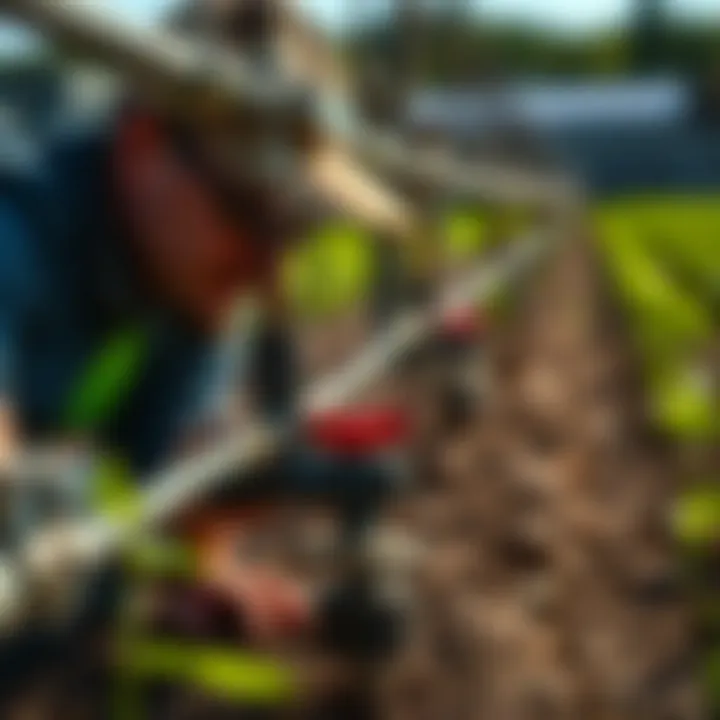
- Tailored Nutrient Delivery: Depending on the growth phase of the crops, adjusting the nutrient load can produce remarkable results. For instance, young plants often require different nutrients compared to mature ones.
- Reduced Environmental Impact: Since the system can minimize excess fertilizer application, the chances of nutrient leaching into nearby water sources decline significantly.
- Enhanced Crop Quality: Delivering nutrients efficiently may lead to improved fruit and vegetable quality, positively affecting marketability and profitability.
Incorporating these practices isn’t just about technology but also understanding the agricultural environment fundamentally. As farmers dive into using fertigation and integrated technologies, the prospects are not only about achieving higher output but ensuring sustainable practices for future generations.
Case Studies in Successful Irrigation
Case studies play a pivotal role in understanding the real-world application of drip line fertilizer injectors. They showcase how these systems can transform agricultural practices, illustrating both the benefits and challenges faced by farmers. These narratives provide invaluable insights, guiding others in the industry who are keen on implementing similar solutions. Through detailed examples, readers can grasp the tangible impacts of drip line technology and align their strategies with proven results.
Small Scale Farms
In small scale farming, where every drop of water and nutrient counts, implementing drip line fertilizer injectors can yield impressive results. For instance, consider a family-owned organic farm, located in the heart of California’s Central Valley. This farm specializes in growing tomatoes and cucumbers. A few years back, they struggled with outdated irrigation methods that wasted both water and fertilizers. After switching to a drip irrigation system, not only did they see a decrease in water usage by over 30%, but the crop yield also saw a significant upsurge.
The change allowed them to target specific areas of the field with precise nutrient delivery. As a result, the plants received just what they needed without the risk of runoff that often accompanies traditional methods. Fewer nutrients washed away meant less environmental impact as well. The family reported their profits doubled within one season due to healthier crops and reduced overhead costs. This also increased their credibility with customers who are keen on sustainability.
Some key takeaways from their experience include:
- Increased Efficiency: The drip line system provided consistent watering and nutrition.
- Cost-Effectiveness: Lowered water bills and reduced fertilizer expenses were realized.
- Sustainability Focus: The farm became a shining example of environmental responsibility.
Commercial Agricultural Operations
Turning our gaze to larger commercial agricultural operations further underscores the advantages of drip line fertilizer injectors. A prominent example can be found in a large-scale almond farm in Texas, which transitioned to this technology in an effort to maximize productivity while minimizing environmental impact.
Initially, the farm faced challenges with soil salinity and uneven crop growth. The implementation of a state-of-the-art drip line fertilizer injector system allowed them to fine-tune the delivery of water and nutrients directly to the root zones of their almond trees. This resulted in a marked improvement in tree health and nut quality. Regular monitoring and adjustments based on real-time data helped optimize the injection rates according to seasonal needs.
This case highlights several critical aspects:
- Precision Agriculture: Adopting advanced technology for precise nutrient application leads to better outcomes.
- Data-Driven Decisions: Continuous data monitoring enhances the ability to make informed choices.
- Long-term Viability: Such systems support sustainable agriculture practices, making it not only profitable but also eco-friendly.
"These systems not only improve crop yield but also contribute to responsible farming, which is the need of the hour in today’s changing climate."
Examining these case studies indicates that drip line fertilizer injectors are not just a trend, but a necessary evolution in farming techniques that can lead to greater efficiency, sustainability, and profitability.
Future Trends in Drip Line Fertilizer Technology
As agriculture continues to evolve, the innovations related to drip line fertilizer technology play a pivotal role in shaping sustainable farming practices. The shift towards environmentally friendly, efficient farming highlights the need for advanced methodologies that offer both productivity and resource conservation. In the realm of drip line fertilizer injectors, several future trends are poised to impact how farmers approach irrigation and fertilization.
Smart Irrigation Solutions
The integration of smart technology into drip irrigation systems is one of the most promising trends. Smart irrigation solutions employ sensors and real-time data analysis to monitor soil moisture levels, weather patterns, and plant health. This data informs the irrigation schedule, ensuring that water and nutrients are applied precisely when and where they are needed.
- Benefits of Smart Irrigation:
- Resource Efficiency: Reduces water waste by supplying only the required amounts.
- Cost Savings: Lowers fertilizer and water bills by optimizing usage.
- Enhanced Crop Yields: Supports healthier crops through targeted nutrient delivery.
For instance, farmers using systems like the CropX platform can see their crop health improve significantly when they apply inputs based on accurate data rather than assumptions. In the case of a chili farm, tailored irrigation based on soil data led to a significant yield increase, demonstrating the tangible benefits of smart solutions in agriculture.
Sustainability Initiatives
Sustainability is at the forefront of agricultural innovation, with many farmers actively seeking practices that reduce their ecological footprint. Drip line fertilizer injectors will increasingly play a role in these sustainability initiatives by promoting better use of inputs while minimizing runoff and nutrient leaching. This is critical in protecting water sources from contamination and ensuring long-term soil health.
- Key Considerations for Sustainability:
- Nutrient Management: Employing precise measurement tools to avoid over-fertilization.
- Reduced Environmental Impact: Minimizing chemical runoff through controlled application.
- Soil Health Improvement: Enhancing soil quality through consistent and adequate feeding.
A case in point is the adoption of biodegradable fertilizers in conjunction with drip systems. These fertilizers break down slowly, releasing nutrients over time and preventing wastage. This method not only supports crop growth but also aligns with broader sustainability goals, helping farmers achieve certifications recognized by organizations such as the USDA.
"Farmers are not just stewards of the land; they are now also part of a global effort to create sustainable practices that will benefit generations to come."
By embracing smart irrigation and focusing on sustainability, farmers not only enhance productivity and efficiency but also contribute to the preservation of natural resources. As these trends unfold, they pave the way for a future where agriculture harmoniously coexists with the environment, ensuring that the technology that feeds the world does so responsibly.
End
In wrapping up our exploration of drip line fertilizer injectors, it’s crucial to understand their significance not just in the context of modern agriculture, but as a fundamental innovation that impacts various segments within the field. The growing demand for efficiency in both nutrient delivery and water conservation makes these systems indispensable for farmers striving to optimize productivity while adhering to sustainable practices.
By employing drip line fertilizer injectors, farmers can enhance the precision of nutrient application. This can lead to healthier soil, improved crop yields, and a tangible reduction in environmental footprints. However, simply installing these systems isn't a panacea. Farmers must remain vigilant about maintenance and education to maximize their utility and longevity. The intricacies of installation, operation, maintenance, and integration with other agricultural technologies should not be overlooked, as these factors greatly influence the overall success of the system.
"Adopting modern practices isn't just about the tools; it's about understanding how to fully leverage them for optimal results."
Summary of Key Points
- Efficiency in Nutrient Delivery: Drip line fertilizer injectors provide targeted nutrient application, ensuring that crops receive what they need precisely when they need it. This leads to healthier plants and potentially higher yields.
- Water Conservation: By allowing for better control over water usage, these systems help conserve one of our most essential resources. This is particularly relevant in regions prone to drought or water scarcity.
- Cost-Effectiveness: Although the initial investment may seem steep, the long-term labor and resource savings make drip systems an attractive option for many growers.
- Integration Opportunities: When combined with advanced irrigation systems and fertigation techniques, the benefits multiply, paving the way for smarter agricultural practices.
Final Thoughts on Drip Line Fertilizer Injectors
Firmly anchored in both tradition and innovation, drip line fertilizer injectors are more than mere tools; they represent a shift towards more deliberate and thoughtful farming. As the agricultural landscape continues to evolve, embracing these technologies becomes not just beneficial but essential. The intersection of science and practice in agriculture must be leveraged to ensure sustainable food production for future generations. In the remarkable journey towards more efficient farming, drip line technology stands as a cornerstone that many growers should consider integrating into their operations to nurture not just their crops, but also the environment.



